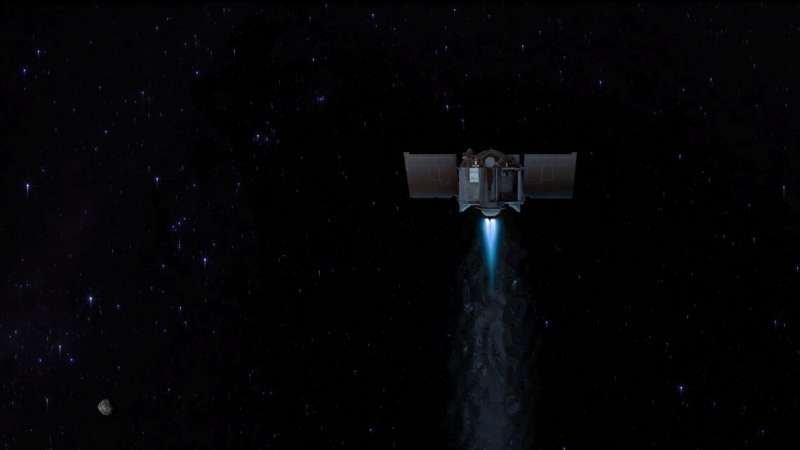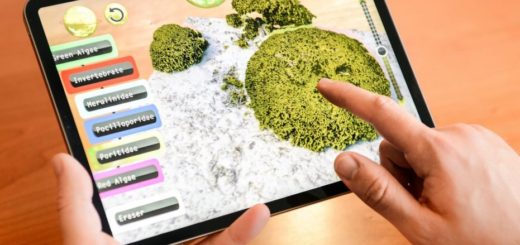OSIRIS-REx mission plans for May asteroid departure

Since its launch in September 2016, the OSIRIS-REx spacecraft has traveled billions of miles, mapped the surface of an asteroid in unprecedented detail, and made new scientific discoveries about near-Earth asteroids. Now, it’s preparing to bring a piece of asteroid Bennu home.
On May 10, NASA’s OSIRIS-REx spacecraft will say farewell to asteroid Bennu and begin its two-year journey back to Earth, where the dust and rocks collected during the Touch-And-Go maneuver in October will be studied by scientists, including OSIRIS-REx mission principal investigator and University of Arizona planetary scientist Dante Lauretta.
During its Oct. 20, 2020, sample collection event, the spacecraft collected a substantial amount of material from Bennu’s surface, likely exceeding the mission’s requirement of 2 ounces, or 60 grams. The spacecraft is scheduled to deliver the sample to Earth on Sep. 24, 2023 in the Utah desert.
The May departure date allows the spacecraft to consume the least amount of fuel and also provides the OSIRIS-REx team with the opportunity to plan a final spacecraft flyby of Bennu. This activity was not on the original mission schedule, but the team is studying the feasibility of a final observation run of the asteroid. They want to learn how the spacecraft’s contact with Bennu’s surface altered the sample site.
If feasible, the flyby will take place in early April and will observe sample site Nightingale from a distance of approximately 2 miles. Bennu’s surface was considerably disturbed after the Touch-and-Go, or TAG, sample collection event, with the collector head sinking 1.6 feet into the asteroid’s surface. The spacecraft’s thrusters also disturbed a substantial amount of surface material during the back-away burn.
The mission is planning a single flyby, mimicking one of the observation sequences conducted during the mission’s Detailed Survey phase in 2019. OSIRIS-REx would image Bennu for a full rotation to obtain high-resolution images of the asteroid’s northern and southern hemispheres and equatorial region. The team would then be able to compare these new images with the previous high-resolution imagery of Bennu obtained during 2019 to inspect how the sample site was altered as a result of the sample collection event.
These post-TAG observations would also give the team a chance to assess the current functionality of science instruments onboard the spacecraft—specifically the OSIRIS-REx Camera Suite, OSIRIS-REx Thermal Emission Spectrometer, OSIRIS-REx Visible and Infrared Spectrometer and OSIRIS-REx Laser Altimeter. It’s possible that the instruments were coated by dust during the sample collection event, and the mission team wants to evaluate the status of each. Understanding the health of the instruments is also part of the team’s assessment of possible extended mission opportunities after the sample is delivered to Earth.
The spacecraft will remain in asteroid Bennu’s vicinity until May 10, when the mission will enter its Earth Return Cruise phase. Upon arrival to Earth, OSIRIS-REx will jettison the Sample Return Capsule. The capsule will then travel through the Earth’s atmosphere and land under parachutes at the Utah Test and Training Range.
Upon recovery, the capsule will be transported to the curation facility at NASA’s Johnson Space Flight Center in Houston. The sample will be distributed to laboratories worldwide, including the University of Arizona, allowing scientists to study the formation of the solar system and Earth as a habitable planet.



 Creators of mankind
Creators of mankind Description of “Tall white aliens”
Description of “Tall white aliens” Where they came from?
Where they came from? About hostile civilizations
About hostile civilizations The war for the Earth
The war for the Earth “Tall white aliens” about eternal life
“Tall white aliens” about eternal life Video: “Nordic aliens”
Video: “Nordic aliens” Aliens
Aliens Alien encounters
Alien encounters The aliens base
The aliens base UFO
UFO Technology UFO
Technology UFO Underground civilization
Underground civilization Ancient alien artifacts
Ancient alien artifacts Military and UFO
Military and UFO Mysteries and hypotheses
Mysteries and hypotheses Scientific facts
Scientific facts


















